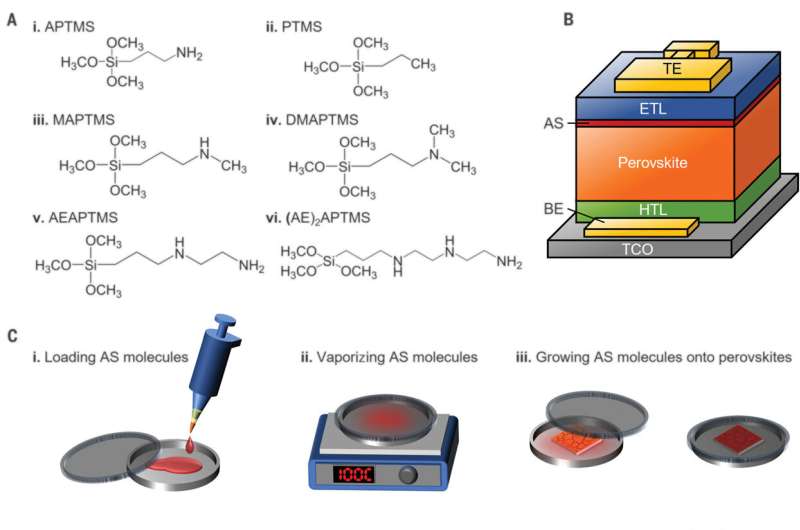
August 1, 2024 by Hong Kong University of Science and Technology
Collected at: https://techxplore.com/news/2024-08-code-boost-solar-cell-efficiency.html
Photovoltaic (PV) technologies, which convert light into electricity, are increasingly applied worldwide to generate renewable energy. Researchers at the School of Engineering of the Hong Kong University of Science and Technology (HKUST) have developed a molecular treatment that significantly enhances the efficiency and durability of perovskite solar cells. Their breakthrough will potentially accelerate the large-scale production of this clean energy.
A key to the solution was their successful identification of critical parameters that determine the performance and lifespan of halide perovskites, a next-generation photovoltaic material which has emerged as one of the most promising materials in PV devices for its unique crystal structure. The findings have been published in Science.
Led by Assistant Professor Lin Yen-Hung of the Department of Electronic and Computer Engineering and the State Key Laboratory of Advanced Displays and Optoelectronics Technologies, the research team investigated various ways of passivation, a chemical process that reduces the number of defects or mitigates their impact in materials, thereby enhancing the performance and longevity of devices comprising these materials. They focused on the “amino-silane” molecular family for passivating perovskite solar cells.
“Passivation in many forms has been very important in improving the efficiency of perovskite solar cells over the last decade. However, passivation routes that lead to the highest efficiencies often do not substantially improve long-term operational stability,” Prof. Lin explained.
For the first time, the research team showed how different types of amines (primary, secondary, and tertiary) and their combinations can improve perovskite films’ surfaces where many defects form. They achieved this using both “ex-situ” (outside the operating environment) and “in-situ” (within the operating environment) methods to observe molecules’ interactions with perovskites.
From there, they identified molecules that substantially increase photoluminescence quantum yield (PLQY), i.e. the quantity of photons emitted during materials excitation, indicating fewer defects and better quality.
“This approach is crucial for the development of tandem solar cells, which combine multiple layers of photoactive materials with different bandgaps. The design maximizes the use of the solar spectrum by absorbing different parts of sunlight in each layer, leading to higher overall efficiency,” Prof. Lin said.

In their solar cell demonstration, the team fabricated devices of medium (0.25 cm2) and large (1 cm2) sizes. The experiment achieved low photovoltage loss across a broad range of bandgaps, maintaining a high voltage output.
These devices reached high open-circuit voltages beyond 90% of the thermodynamic limit. Benchmarking against about 1,700 sets of data from existing literature showed that their result was among the best reported to date in terms of efficiency in energy conversion.
Even more critically, the study demonstrated remarkable operational stability for amino-silane passivated cells under the International Summit on Organic Solar Cells (ISOS)-L-3 protocol, a standardized testing procedure for solar cells.
Approximately 1,500 hours into the cell aging process, the maximum power point (MPP) efficiency and power conversion efficiency (PCE) remained at high levels. For the best-passivated cells to decrease to 95% of their initial values, the champion MPP efficiency and the champion PCE were recorded at 19.4% and 20.1% respectively—among the highest (when factored for the bandgap) and the longest metrics reported to date.
Prof. Lin emphasized that their treatment process not only boosts the efficiency and durability of perovskite solar cells, but is also compatible with industrial-scale production.
“This treatment is similar to the HMDS (hexamethyldisilazane) priming process widely used in the semiconductor industry,” he said. “Such similarity suggests that our new method can be easily integrated into existing manufacturing processes, making it commercially viable and ready for large-scale application.”
The team included Electronic and Computer Engineering Ph.D. student Cao Xue-Li, Senior Manager of the State Key Laboratory of Advanced Displays and Optoelectronics Technologies Dr. Fion Yeung, along with collaborators from Oxford University and the University of Sheffield.
More information: Yen-Hung Lin et al, Bandgap-universal passivation enables stable perovskite solar cells with low photovoltage loss, Science (2024). DOI: 10.1126/science.ado2302
Journal information: Science

Leave a Reply